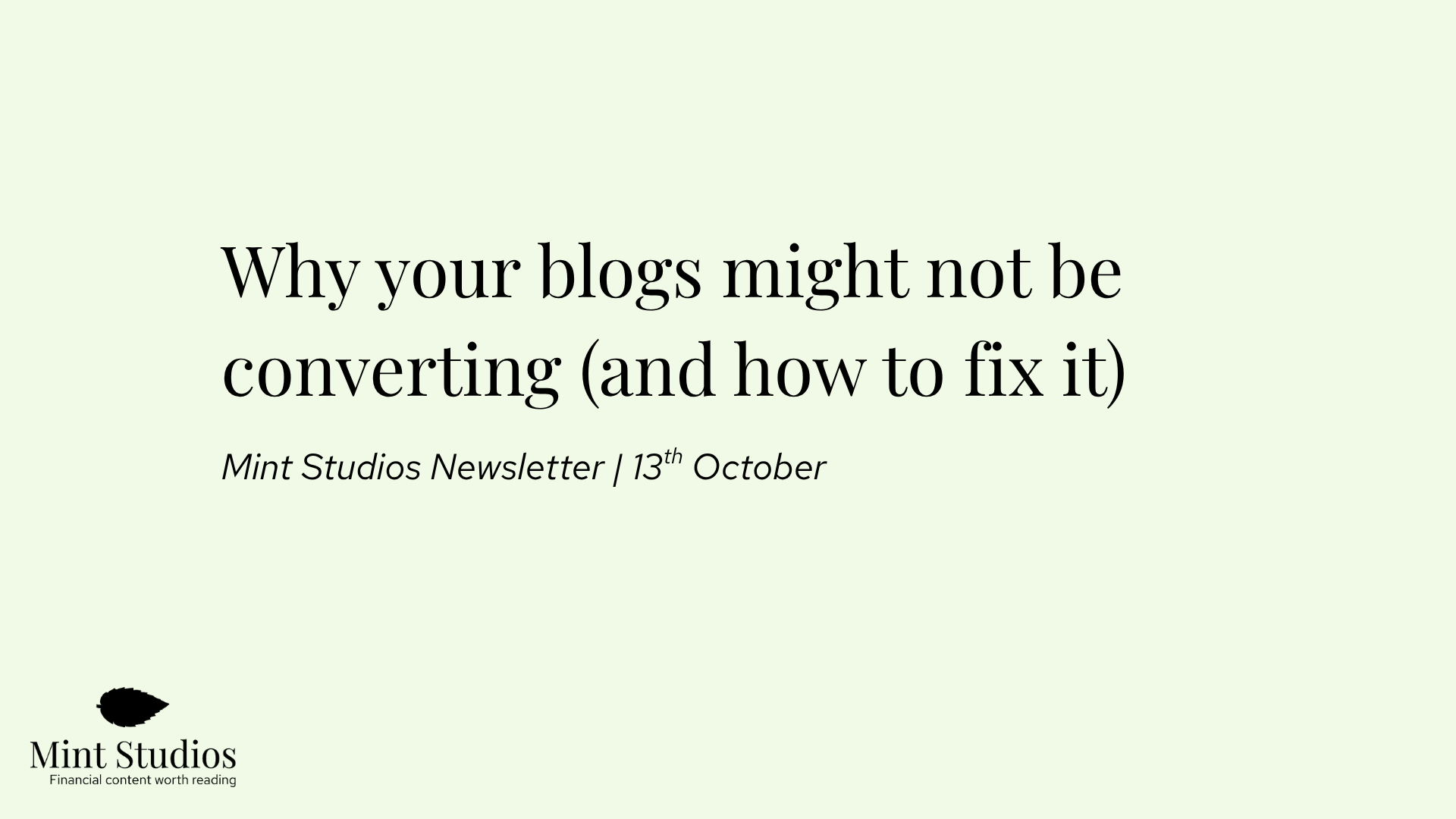Whenever we talk to a fintech company who’s looking to do content marketing, the term “thought leadership” nearly always comes up.
Every company we talk to says that their eventual goal is to be seen as a thought leader in the space. Ideally, three years from now, their company is well respected in the field and is known amongst those who matter.
Content marketing plays a large role in establishing a company as a thought leader, but it’s not a silver bullet: there is so much more that goes into becoming a thought leader.
In this article, we want to explore the role of content marketing in becoming a thought leader. We’ll be covering what it means exactly to be a thought leader, and what are the steps to becoming one.
Let’s go!
What does it mean to be a thought leader?
When we ask the person working at the fintech company to elaborate on what they mean by becoming a thought leader, here’s how they describe it:
- They are invited to speak at events, speak on well-known podcasts or contribute to an article.
- When they go to an event, people already know who they are and want to speak to them.
- They have a good following on LinkedIn or social platforms.
Why does everyone want to become a thought leader? Because in the B2B space, sharing expertise is the best marketing strategy. With high ticket sales, trust plays a much bigger role than low cost items. We’re also a lot more likely to trust someone who has demonstrated their expertise.
The issue is that in practice, it seems people have different ideas of what it really means to be a thought leader. We thought we’d start off by first looking at who the current thought leaders are.
We asked The Fintech Marketing Slack group for some examples of thought leaders, and what’s interesting is that of the 13 responses, only one was a company (11FS). What’s interesting here is that thought leaders are usually described as people, rather than a company.
Here are the names people mentioned:
- Anne Boden (Starling)
- Hannah Fitzimons (Cashflows)
- Brian Hanrahan (Nuapay)
- Paul Thomalla (Finastra)
- Brett King (Moven)
- Simon Taylor (Fintech brainfood)
- Alex Johnson (Fintech Takes)
- Nicole Casperson (fintech is femme)
- Philippe Gelis from Kantox
- Ron Shevlin
- Leda Glyptis
- Lorde Astor West
It’s a lot easier to come up with “people thought leaders” than “company thought leaders”.
Sure, companies like Stripe, Adyen, Marqeta are well known in the industry: but would you subscribe to their newsletter/content to learn more about how they think? Maybe. But you’re a lot more likely to subscribe and follow content from a specific person, rather than an organisation.
Which is why we think it’s important to distinguish between two types of “thought leadership”:
- Brand awareness: where your company is known in the space, people have heard of it when you introduce yourself and your company name/logo appears at events, podcasts and some press.
- Loyal audience: where people actively follow you and read/listen/watch your content because they want to hear your opinion on current trends, enjoy consuming your content and consume it regularly.
Becoming either of these types of thought leadership is hard. But we would argue the second one is a lot harder, for a few reasons:
- You have to be a genuine thought leader, and have a point of view or something to add to the conversation.
- You have to be a person, rather than a company.
There are very few companies that have a loyal audience. There are, however, plenty of people who have a loyal audience, and we mentioned a few earlier on (you could argue these are also called influencers, or maybe “finfluencers”? 😛).
If one of your goals as a marketing lead at a fintech company is to “become a thought leader”, you then have to ask yourself another question: what type of thought leader do you want to be?
Do you want people religiously reading your content? Or do you want to be known in the industry?
There is also a third type of thought leadership that people don’t talk about, and that we think is a lot more achievable and that regular companies (i.e. not super famous ones) should consider focusing on:
3. Expert content: where people won’t actively follow you and read every single piece of content, but if they come across some of your content and read it, they’ll see you as an expert and might engage with you in the future. In other words, they only see you as an expert after they’ve read your content. Your name and brand have nothing to do with how they see you, it’s the content that matters.
We would argue that these three buckets of thought leadership represent the journey of becoming a thought leader:
- Expert content: you publish content that has a unique point of view and is clearly from expertise. Some people read it and see you as an expert.
- Brand awareness: as you continue to publish content, you then start participating in podcasts, events and PR. Your company starts to become known in the marketplace.
- Loyal audience: many years down the line, two to three people on your team are known as thought leaders, and they have an audience who reads and consumes the content that they put out.
Let’s use Monzo as an example of a company/person that has all these three types of thought leadership:
Expert content: Imagine you’ve found yourself in a situation where you’ve struggling to save money. You do some online research, and come across an article on “old school” ways to save money. It’s a pretty good article with some genuinely useful tips. It won’t turn you into a Monzo evangelist, but that piece of content will stick in your mind (you might even bookmark it for later), which means you might be more likely to become a Monzo customer later on.
Brand awareness: As a company, Monzo has tremendous brand awareness. You can tell because if a virtual event or panel has someone from Monzo on, attendance is huge.
Loyal audience: It’s unlikely anyone follows Monzo’s blog religiously and we wouldn’t say that Monzo as a company has a loyal audience of readers that read their expert content (social media is different because you don’t follow them for their expertise).
However, they do have people in the organisation with loyal audiences. There’s Tom Blomfield (the ex-CEO/founder), but the best example is Richard Cook (their Senior Social Media Manager). Every month, Richard sends a newsletter with his own unique takes on what’s happening in social media via his Substack, The Social Roast. Having the Monzo brand behind him helps, but ultimately it’s Richard who is the thought leader – not Monzo.
What’s the takeaway here? We’ll get into that in more detail. But if there is one thing we can be certain about: regular companies (not people) cannot build a loyal audience, without first creating expert content and brand awareness.
How do you become a thought leader?
There is no right answer to this. But based on the work we’ve done with clients and the work we’ve done building the Mint Studios brand, here’s how we would answer that question.
First of all, we believe it makes more sense to first be seen as a thought leader to those who are closer to becoming your customers, especially if your company is earlier in their growth journey:

This way, you’ll get results sooner: by targeting people who are aware they have a problem, know what the solution is and are actively looking for it, the conversion rates will be higher and the sales cycles shorter. t
We won’t go into more detail about this approach since we’ve written about it extensively on the blog before. You can read more here: What is BOFU (Bottom of the Funnel) Content and Why Is it Important?.
If you agree that it’s worth targeting those closer to the bottom of the funnel first, then here’s how we would go about becoming a thought leader:
Step 1: Create expert written content
You can’t become a thought leader if you don’t produce some kind of content, and the easiest type of content to start with is written content: blog posts, eBooks, guides, or even a book. Written content has a lower barrier to entry than video content or podcasts, so it’s naturally a good place to start.
If resources are limited and you want to make the most of your content, we would recommend creating “multi-purpose” written content. These are articles and guides that:
- Cover topics that your best customers would read
- Are based on interviews with internal experts on your team, and therefore add genuine value
- Rank on Google for keyphrases that prospects who don’t know about your brand might be searching for, so help with brand awareness (e.g. getting your brand ranking on the first page of Google for “direct debit provider”).
- Are designed to help with conversions by targeting people who are closer to converting.
By creating these multi-purpose articles, you’re becoming a content thought leader, while also increasing the brand awareness of your product and also getting customers.
If you’re not a super famous company, this type of content is a good place to start. We’ve written about how to create these types of articles many times before:
- Why You Should Create Content Based on Interviews With Experts
- The Content Tower of Pisa: Why Fintech Content Programmes Fail
But creating this type of content won’t turn you into a thought leader overnight. It’ll help you get customers and position you as an expert amongst those who are actively looking for a solution like yours. It’s a good start, but it won’t turn you into the classic “thought leader”.
We believe that this level of thought leadership is often enough for a company. Creating expert content gets you customers, it helps raise the awareness of your brand amongst those who are close to converting and they’ll also see you as an expert. If you’re early in your growth journey, your goal is likely to acquire customers – and this type of content will help you with exactly that.
If what you really want is to be well known in the industry, content marketing alone won’t get you there. We now move onto the next stage: improving brand awareness. To get there, you need to invest in other mediums.
Step 2: Increase brand awareness
Let’s say you’re regularly creating expert content and it’s bringing in customers and working well for you. You now want to start increasing the awareness of your brand and establishing your company in the market.
There are different ways to do this, but we would say there are a few mediums that are important to invest in.
- Speaking at events
Speaking at events is a very effective way to establish yourself as a thought leader. If you’re willing to talk on a stage to 100+ people, people automatically see you as an expert.
Contrary to what people think, however, you won’t always get these opportunities by sitting back and waiting for someone to ask you to speak at an event. You can kickstart this yourself by:
- Pitching to speak at events (M2020 USA just called out for a pitch, for example)
- Organising your own events, and then speaking at them or moderating them.
You can find a list of fintech events to speak at here: Fintech Events
2. Speaking on podcasts
This can be a hit or miss, since it does depend on how big the podcast is. However, we’ve heard success stories from fintech leaders sponsoring or coming on a podcast, and that has helped with brand awareness.
You can either wait for someone to ask you to come on, or you can put together a list of podcasts and then ask them if you can come on. Make sure it’s personalised and relevant to them.
You can find a list of fintech podcasts here: Top 4 Fintech Podcasts for Fintech Nerds in 2023
3. Creating content on social media
The main benefit of having brand awareness is that you stay on top of people’s minds. When they face a problem, they know to go directly to you when they have an issue.
One of the easiest ways to stay on top of people’s minds is to publish regularly on the platforms where they are, such as LinkedIn or Twitter.
We’re no social media experts, so we can’t offer the best guidance. However, we do know that Caleb, founder of Payfac-as-a-service Tilled, got a lot of success from publishing regularly on LinkedIn and building a following of 13,000+ people. From his LinkedIn and content marketing, Tilled is now at a point where 75% of their leads are inbound and he’s got an astounding 59% close rate.
Read the case study here: How This Payments Company Gets 75% of Leads Inbound and a 59% Close Rate with Content Marketing
4. Having a unique perspective
Ultimately, it’s a lot easier to become a thought leader if you have a unique position in the market. The people who become thought leaders the fastest are those who are well positioned vertically, horizontally and also have a unique perspective.
For example, Caleb, founder of Tilled, believes that every software company should be able to monetise payments. That perspective is what helped him stand out in the market and be seen as the alternative to Stripe.
Gihan, CEO of Communique, focuses only on ESG and fintech, and believes that ESG should be part of every fintech company’s business strategy.
When you have a unique point of view, people will come to you to hear what you think about a specific problem or issue. You’ll be known as the “ESG & fintech” expert, or the “Payfac as a service” company. Having very tight positioning helps a lot with becoming more memorable, and therefore with becoming a thought leader.
At Mint Studios, for example, we can confidently say that we are the only content marketing agency in the fintech industry that specialises in helping fintech companies using content for customer acquisition.
As you can imagine this ties a lot into product and business strategy. If you’re the only payment company focusing on this issue or segment, it’s a lot easier to have a unique point of view.
Step 3: Build a loyal audience
What’s the next step after increasing brand awareness? It could be building a loyal audience. Again, we would argue that not every company needs to do this and that you’ll get most of the benefits with brand awareness.
Building a loyal audience is hard, and we would argue there are mixed benefits for the company. We’ve already established that you really need to be a person, not a company, to build a loyal audience. So what happens when the thought leader leaves the company? When you have thought leaders within your company with a large audience, it’s a huge bonus for your company. However, this can also hurt your company a lot when they leave.
A great example is Simon Taylor, co-founder of 11FS. He built a following of over 30,000 via his Fintech Brainfood Substack. When he was at 11FS, it’s clear this newsletter benefitted the company (he would sometimes link to their reports, for example). He’s now left 11FS and now works for Sardine, a fraud and risk platform for fintechs. Sardine has gained a lot of credibility by having Simon on their team – however, there’s no denying that 11FS lost out on a bit of “thought leadership credibility” when he left.
There are many of these examples outside of the world of fintech: Rand Fishkin and Moz, Dave Gerhard with Drift.
These thought leaders know how powerful their audience is, which is why many of them eventually go on to work for themselves or to have their own company. In the fintech world, people like Chris Skinner, Brett King and Alex Johnson work for themselves.
When people follow thought leaders like that, they are following the person, not the company. So it’s up to you to make a decision on whether to start building a loyal audience.
And in terms of how to start? That’s a topic for a whole other article, and it’s not one we’re experts in. The best advice would be: find someone on your team who’s an expert, and then ask them to start creating content. Or take Tilled’s approach and ask someone else to interview the expert and create content.
Ok, where do I start?
It’s unlikely that you’re aiming to build a loyal audience via one thought leader on your team: what’s more likely is that you want to help improve brand awareness of your company in a way that helps generate leads and also establishes you as an expert.
Here’s what you can do to get started:
Write about expert topics with multi-purpose content
When you are a smaller company, we believe you should take a different approach to thought leadership. No one cares about your “thoughts on the future of payments” if you haven’t established yourself as a thought leader yet. Which is why you should first start out by creating content on what you know about and that also serves another purpose: e.g. brand awareness or customers acquisition. This is why you want to start with multi-purpose content:
- Expert-based: Content that is based on knowledge of experts in your company (you can do this with content interviews)
- Raises awareness: There are different ways to do this, but our favourite is with SEO. By ranking for “direct debit payment provider”, you’re raising awareness for your brand amongst potential prospects
- Acquires customers: By writing for your ideal audience and prospects who are at the bottom of the funnel, you’re more likely to convert them. Start by writing on content on these topics.
Build your brand on other mediums
Pick 2 - 3 people who will be designated experts for your company. These are the people who will:
- Go on podcasts
- Speak at events
- Creating content on social media
- Have their profiles highlighted in your content
It’s important to pick multiple people: your goal here is to make your company the thought leader, not just the person.
Building brand awareness will take years, but as people on your team build their profiles over various mediums and you continue to create expert content, you’ll see awareness of your brand increase – as well as an increase in leads via your distribution channels.
Our final thoughts on this is: we believe people should move away from creating purely “thought leadership content”, and move towards creating content that has a distinct purpose, such as conversions or brand awareness, and that is always based on expertise. In the B2B world, it doesn’t make sense to not create expert content, so if you’re going to create content, thought leadership should be everywhere.
To truly become a thought leader, you want to commit to having communication that always exudes expertise.
We hope this article is somewhat useful, if anything, it has hopefully given you some food for thought on the topic of becoming a thought leader. And if your leadership team keeps asking “when we’ll be thought leaders”, you can explain to them the different types of thought leadership, and which one makes more sense to pursue as a company.











